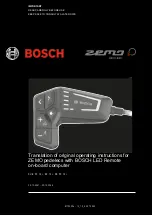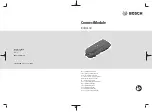
46
I General User Manual
If you hear unusual noises when braking, the brake blocks
may have reached their wear limit. Allow the brakes to
cool down then check the brake block depth. Have the
brake blocks replaced if necessary.
When installing, removing and carrying out mainte-
nance on the wheel, do not touch the brake disc with
your fingers when it is turning. You could be seriously
injured if you catch your fingers in the cutouts of the
brake disc.
The brake calliper and the disc can become extremely
hot when braking. You should therefore not touch
these parts when riding the bike or immediately after
dismounting as you could burn yourself. Before ad-
justing the brakes, check that the parts have cooled
down sufficiently.
You must only fit a disc brake on your bike providing
suitable mounting devices are installed on the frame
and the bike fork. If in doubt, consult a specialist
cycle shop.
If the brake blocks come into contact with oil or grease,
they must be replaced. If the brake disc comes into con-
tact with oil or grease, it must be cleaned as otherwise its
braking performance will be drastically reduced.
Check whether the quick-release lever for the wheel is
on the side opposite the brake disc. If the quick-release
lever is on the same side as the brake disc, there is a
danger you could burn yourself when operating the lever.
The heat in the brake disc could also reduce the clamping
force of the quick-release device.
If the brake disc is worn, cracked or bent it must be re-
placed. Have this work carried out by a professional bike
workshop.
If the depth of the brake blocks is less than 0.5 mm, they
must be replaced.
> 0.5 mm
0.5 mm
21.5.1 Hydraulic disc brake
The hand brake lever of the hydraulic disc brake is
equipped with a master cylinder. The hydraulic fluid is
fed through a tube to the brake cylinders. This actuates
the brake pistons which push the brake blocks against the
brake disc. This type of brake requires little maintenance
and can be very powerful.
Once the brakes have been adjusted, always perform
a brake test by pushing the bike quickly forwards and
operating the brake lever. You should only use your
bike if you can safely stop it using the brakes.
Check regularly, also before each journey, that the lines
and connections are tight. If lines and connections are not
tight, brake fluid may escape from the brake system. The
brake may not work properly as a result.
If fluid escapes from the braking system, do not use the
bike and have the necessary repair work carried out im-
mediately by a professional bike workshop.
If you continue riding the bike in this condition, the risk
of brake failure is extremely likely.
If the brake blocks come into contact with oil or grease,
they must be replaced. If the brake disc comes into con-
tact with oil or grease, it must be cleaned as otherwise its
braking performance will be drastically reduced.
















































